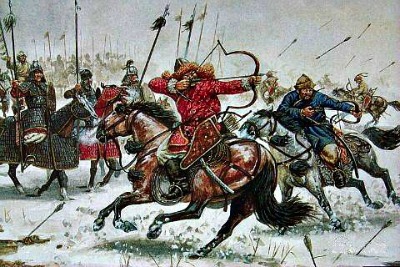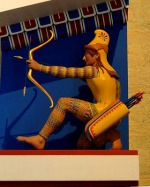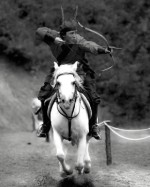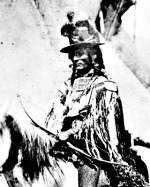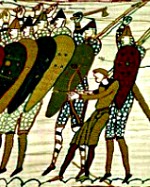The History of Mongolian Archery
Talk the Talk
Traditional Mongolian archery has its own technique for shooting a bow known as the Mongolian release, the Mongolian draw or the Asiatic grip.
Right-handed archers hold the bow in their left hand and push it forward until the arm is fully extended while the right arm pulls the string back behind the ear.
Because of the power of the Mongolian bow, they also use a special technique to hold the string.
The Mediterranean draw predominantly used in the West uses the first three fingers to draw the bow string. However, the technique used in Mongolian archery is to pull the
string back with the thumb which is supported by the index finger curling around and placed atop the outermost joint, exactly at the base of the nail.
They also use a special thumb ring which is hooked on the string before release to protect the thumb from damage. The ring can be made of various materials including jade, agate, leather, metal or bone.
Walk the Walk
Right up until the nineteenth century when effective breech-loading firearms became common, the composite bow used by Mongolian warriors was far superior to any long-range
weapon used in the West.
The longbow was the most effective bow produced in the history of archery in Europe and was used extensively during the Middle Ages. However, the innovative design of the Mongolian bow made it lighter and smaller but with a longer range and greater accuracy.
While the longbow could shoot at distances of around 228 meters, the
Mongol bow could hit a target around 320 meters away.
Archery Quote
[The Mongolian] arms are bows and arrows, sword and mace; but above all the bow for they are capital archers, indeed the best that are known...They are excellent soldiers and passing valiant in battle.
They are also more capable of hardships than other nations; for many a time, if need be, they will go for a month
without any supply of food, living only on the milk of their mares and on such game as their bows may win them...
~ Marco Polo ~
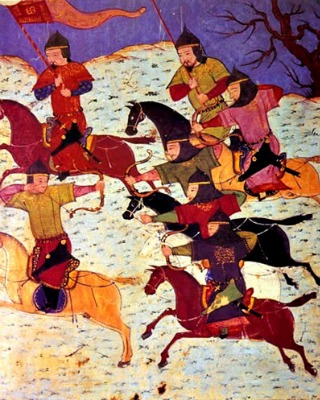 The history of Mongolian archery is so ancient and integral to their culture that there is debate amongst historians over which technological advance came
first in the region, the Mongolian bow and arrow or the wheel.
The history of Mongolian archery is so ancient and integral to their culture that there is debate amongst historians over which technological advance came
first in the region, the Mongolian bow and arrow or the wheel. Traditional Mongolian archery was integral to the nomadic lifestyle they led. As well as being used for hunting, it was their main weapon when fighting neighbouring tribes or when raiding the rich lands of China (and when faced with the retaliatory expeditions from the Chinese that followed).
Ancient Archery in Mongolia
From the third century BCE, sources tell of raids into China by a tribe called the Xiongnu, who predominantly fought with mounted archers. Their tactics must have impressed the Chinese as they
adopted them and used them to pursue the Xiongnu across the Gobi Desert.
So successful were
the raids of these ancient archers that in a bid to keep out the tribesmen of what is now Mongolia, previously build fortifications were connected making the beginnings of the Great Wall of China. Despite this, raids and wars would be waged against China by the largely nomadic tribes using mounted archers on and off right up to the
modern era.
Mongolian children were taught archery techniques from a young age and the art was so
ingrained in their culture, it was not only a weapon of war but also practised as a sport with tournaments being held regularly in the nomadic camps and at the courts of the Khans. The most important use for the bow on a day-to-day level was hunting and in this,
the Mongol people also excelled. A source from China during the Tang Dynasty (c.618 - 907 CE) stated, “Steppe inhabitants can hit at full tilt a running hare with a single
arrow.”
Female members of the tribes were also prolific with the bow which they used for
hunting and defending the tribe when the soldiers were away. In some cases women could themselves be part of the military, even fighting on the front line as archers alongside their male
counterparts.
Genghis Khan and the Mongolian Empire
Under the leadership of Genghis Khan and his descendants, archery was instrumental in building one of the largest empires the world has ever seen as they swept away most who faced them (with the notable exception of Japan).
A story from a chronical known as the Blue Sutra from the Mongolian Yuan Dynasty (1271 - 1368) in China, demonstrates just how prolific the Mongol warriors were with a
bow.
Genghis’s progress was barred one day by Magnagt, ruler of the Merkits, who
stated:
Even though you are viewed as the son of the heavens, I am still not convinced about the abilities of your soldiers. If any one of them hits with a single arrow a small red flag from a distance of 100 num (one num equals the length of a bowstring, which is almost 1.5 metres), I will become your ally and friend – if not, we will be enemies.
On
hearing Magnagt’s challenge Taitsuu, one of the Khan’s generals, laughed and stated, “You offer us the warrior’s standard exercise.” He then ordered one of his men, Chuu Mergen, to comply with
the challenge who, according to the Blue Sutra, hardly needed to aim. Another of the
Mongol marksmen, Khavt Khasar, then stepped forward proclaiming, “It’s no challenge to hit a motionless target,” then raised his bow and with a single arrow pierced the neck of a drake flying
passed. As the slain bird hit the ground, he hit it with another arrow. Needless to say
that Magnagt was impressed by this, so much so that he not only let the Mongols pass without a fight but also enlisted nine thousand of his own men to Genghis Khan's cause.
Mongolian Archery Techniques, Equipment and Tactics
Each warrior would carry two bows, one for long-range shooting and one for fighting at close range. Mongolian bows were made from ten different materials including birch bark, fish glue, bamboo, deer antlers, natural silk threads and animal tendons, all of which could be found within Mongolia itself. The design of the longer-range bow allowed them to fight at a distance while maintaining accuracy. This meant they could hit opposing forces with salvos of arrows while themselves being out of range, even against enemy militia on fortress walls.
Another Mongolian archery technique often employed was to ride towards their enemies in continuous waves shooting volleys of arrows, often laced with poison, before retreating to get themselves out of range of their enemy’s arrows. While shooting arrows on horseback, a traditional Mongolian archer would dramatically increase his accuracy by timing the release of the arrow to the moment when his horse's hooves were all off the ground which would prevent the motion caused by them hitting the floor from disrupting his aim.
They manufactured several different types of arrow, the composition of which depended on their purpose of use and would often carry two or more quivers with them into war or on hunting expeditions, with each quiver carrying different types of arrow. The most powerful arrows were capable of piercing thick armour and their metal tips could measure 15 cm long and 3.5 cm wide. They also designed some intended for short-range, long-range, double-tipped and arrows designed to be lit on fire.
Amongst the most inventive arrows in archery history was the whistling arrows, which had holes in the tips that made a whistling sound while in flight which would intimidate forces that faced them. They were also useful in hunting as the whistling sound of the arrow shot high in the air could distract the animal, making it look up with curiosity giving the hunter time to shoot a more powerful arrow to bring down the stationary prey.
The Decline and Resurgence of Traditional Mongolian Archery
After the reign of Genghis Khan and his descendants, the nations they conquered would gradually brake away from the empire and life returned largely to the way it had been in earlier phases of Mongolian history. Numerous warring nomadic and semi-nomadic tribes would turn their bows on each other bidding for power and dominance over the region.
From the seventeenth century, both the Russians and the Chinese began to encroach on the lands of Mongolia and they would soon come under the control of the Manchurian Qing Dynasty, inevitably changing their way of life and affecting many of their customs and traditions.
A low point in the history of Mongolian archery followed as it was officially banned due to its military applications. However, it did live on and when the country again became an independent nation in 1911, the practice of traditional archery regained its popularity among the people in just a few years, re-established itself as an integral part of their daily lives and culture.
Written by Andrew Griffiths – Last updated 19/07/2023. If you like
what you see, consider following the History of Fighting on social media.
Further Reading:
Jones, J. [Internet]. 2012. The Late Middle Ages. West Chester University of Pennsylvania. Available from: http://courses.wcupa.edu/jones/his101/misc/latemid.htm [Accessed February 22, 2018].
Mongol Archers. [Internet]. 2013. Warriors and Legends. Available from: https://www.warriorsandlegends.com/mongol-warriors/mongol-archers [Accessed February 22, 2018].
Oestmoen, P.I. [Internet]. 2002. The Mongolian Bow. Coldsiberia.org. Available from: http://www.coldsiberia.org/monbow.htm [Accessed February 22, 2018].
Storey, J. [Internet]. 2000. What Came First in Mongolia - the Wheel or the Bow? Atarn.org. Available from: http://www.atarn.org/mongolian/mn_nat_arch/messenger.htm [Accessed February 22, 2018].
More Archery History
Archery History Home
The bow and arrow has been used since at least the Palaeolithic Era (late Stone Age) and the earliest known composite bow was used in Egypt c.2800 BCE. Ancient and medieval archery were used for hunting and warfare though with the invention of the firearm, modern archery has developed into a popular sport that is enjoyed all over the world.
The bow and arrow has been used since at least the Palaeolithic Era (late Stone Age) and the earliest known composite bow was used in Egypt c.2800 BCE. Ancient and medieval archery were used for hunting and warfare though with the invention of the firearm, modern archery has developed into a popular sport that is enjoyed all over the world.
The History of Archery in Korea
The history of archery in Korea stretches back to pre-history and the bow and arrow has been used there since at least the fifth century BCE. Traditional Korean archers helped to unify the country, gain independence from China and later to fend off Japanese invaders. In modern times, South Korea are
continuously making Olympic archery history and are widely considered to be the best in the world.
Making the Native American Bow and Arrow
To make a Native American bow and arrow needed a large amount of skill. The process was complex but as it provided both food and protection to the tribe, it was a job that needed to be done to a high standard to insure optimum performance.
To make a Native American bow and arrow needed a large amount of skill. The process was complex but as it provided both food and protection to the tribe, it was a job that needed to be done to a high standard to insure optimum performance.
Archery History in Medieval England
Archery history in England saw the use of various forms of bow and arrow, including the short bow, crossbow and the medieval longbow. While the medieval short bow’s usefulness on the battlefield was limited, the crossbow and later the longbow helped English forces defeat much larger opponents which ultimately led to medieval archers gaining respect and prestige.
Archery history in England saw the use of various forms of bow and arrow, including the short bow, crossbow and the medieval longbow. While the medieval short bow’s usefulness on the battlefield was limited, the crossbow and later the longbow helped English forces defeat much larger opponents which ultimately led to medieval archers gaining respect and prestige.
The images on this site are believed to be in the public domain, however, if any mistakes have been made and your copyright or intellectual rights have been breeched, please contact andrew@articlesonhistory.com.

